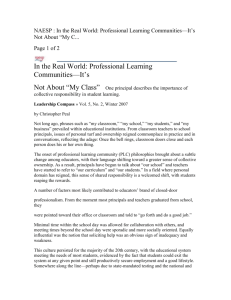KDE Program Review for Practical Living/Career Studies KY Department of Education
advertisement
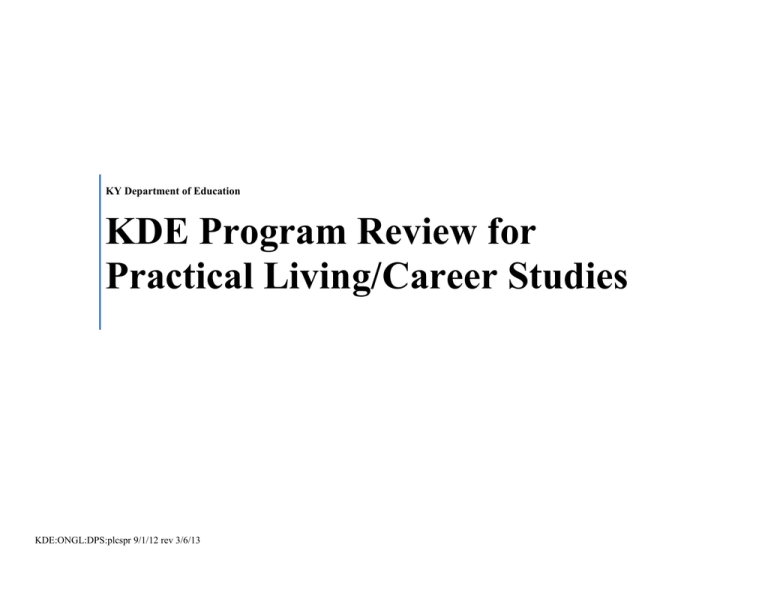
KY Department of Education KDE Program Review for Practical Living/Career Studies KDE:ONGL:DPS:plcspr 9/1/12 rev 3/6/13 PRACTICAL LIVING/CAREER STUDIES: CURRICULUM AND INSTRUCTION Demonstrator 1. Health Education Students have equitable access to high quality, rigorous health education curriculum. No Implementation Needs Improvement a) There is no health education curriculum. a) The health education curriculum is planned but not comprehensive and/or sequential. b) Health education curriculum does not provide opportunities for students to practice the skills embedded in the National Health Education Standards (NHES). b) Health education curriculum provides limited opportunities for students to practice the skills embedded in the National Health Education Standards (NHES) that establish, promote and support health-enhancing behaviors for students in all grade levels. c) c) The health education curriculum provides no strategies and activities that ensure students receive instruction in some of the health education content areas (e.g. family life and human sexuality, alcohol and other drugs, tobacco, nutrition, mental and emotional health, injury and violence prevention, diseases and disorders, physical activity, personal/consumer health, community/environmental health). KDE:ONGL:DPS:plcspr 9/1/12 rev 8/2/13 The health education curriculum provides limited learning strategies and activities that ensure students receive instruction in some of the health education content areas (e.g. family life and human sexuality, alcohol and other drugs, tobacco, nutrition, mental and emotional health, injury and violence prevention, diseases and disorders, physical activity, personal/consumer health, community/environmental health). a) Proficient A comprehensive health education curriculum is sequentially planned and aligns with the Kentucky Core Academic Standards for Practical Living. b) Health education curriculum regularly provides opportunities for all students to become health literate by practicing the skills embedded in the National Health Education Standards (NHES) which establish, promote and support health-enhancing behaviors for students in all grade levels. c) The health education curriculum provides learning strategies and activities that ensure students receive instruction in all health education content areas (e.g. family life and human sexuality, alcohol and other drugs, tobacco, nutrition, mental and emotional health, injury and violence prevention, diseases and disorders, physical activity, personal/consumer health, community/environmental health). Distinguished a) The K-12 health education curriculum utilizes CDC’s Health Education Curriculum Analysis Tool (HECAT) to develop a K-12 (district and/or school) scope and sequence as part of a comprehensive health education program that is aligned to the KCAS for Practical Living. b) Health education curriculum regularly provides opportunities for all students to become health literate by demonstrating mastery of the skills embedded in the National Health Education Standards (NHES) that establish, promote and support healthenhancing behaviors for students in all grade levels. c) The health education curriculum provides learning strategies and activities that ensure students receive annual instruction in all health education content areas (e.g. family life and human sexuality, alcohol and other drugs, tobacco, nutrition, mental and emotional health, injury and violence prevention, diseases and disorders, physical activity, personal/consumer health, community/environmental health). 2 d) There is no Coordinated School Health Committee. d) A Coordinated School Health committee is in place but is not used to inform instructional practices. e) e) There is no integration of the health education curriculum. School has limited opportunities to integrate the health education curriculum into other academic subjects. d) A Coordinated School Heath Committee is used as a support and resource for collaboration and integration of health education instruction throughout the school environment. e) School ensures the health education curriculum is integrated and includes frequent opportunities for cross-disciplinary connections to meet the health and safety needs of all students d) A Coordinated School Health committee annually collects and analyzes data to create/review the school wellness policy and utilizes the policy to guide collaboration and integration of health education instruction throughout the school environment. e) School ensures content of the health education curriculum is frequently integrated into all content areas to meet the health and safety needs of all students Evidence: Rationale: Next Steps: KDE:ONGL:DPS:plcspr 9/1/12 rev 8/2/13 3 Demonstrator 2. Physical Education Students have equitable access to high quality, rigorous physical education curriculum. No Implementation Needs Improvement a) There is no physical education curriculum. b) Physical education curriculum does not provide opportunities for students to become physically literate. c) The physical education curriculum does not provide differentiated learning strategies and/or activities. d) There is no Coordinated School Health Committee. KDE:ONGL:DPS:plcspr 9/1/12 rev 8/2/13 a) The physical education curriculum is planned but not comprehensive and/or sequential. b) Physical education curriculum provides limited opportunities for students to become physically literate individuals who have the psychomotor, cognitive, and affective skills to adopt a physically active lifestyle as defined by the National Association for Sport and Physical Education (NASPE) National Physical Education Standards. c) The physical education curriculum provides limited differentiated learning strategies and activities. d) A Coordinated School Health committee is in place but is not used to inform instructional practices and/or increase physical activity opportunities within the school environment. a) Proficient A comprehensive physical education curriculum is sequential and aligned to the Kentucky Core Academic Standards for practical living. b) Physical education curriculum regularly provides opportunities for all students to become physically literate individuals who have the psychomotor, cognitive, and affective skills to adopt a physically active lifestyle as defined by the National Association for Sport and Physical Education (NASPE) National Physical Education Standards c) The physical education curriculum frequently provides differentiated learning strategies and activities that ensure all students develop competency and confidence in motor skills that fosters the necessary knowledge for life-long physical activity. d) A Coordinated School Health committee utilizes a Comprehensive School Physical Activity Program (CSPAP) to increase the quality of the physical education instruction as well as increase physical activity opportunities throughout the school environment. Distinguished a) The physical education curriculum utilizes CDC’s Physical Education Curriculum Analysis Tool (PECAT) to develop a K-12 (district and/or school) scope and sequence; as part of a comprehensive physical education program that is aligned to the KCAS for practical living. b) Physical education curriculum regularly provides opportunities for all students to become physically literate individuals who demonstrate mastery of psychomotor, cognitive, and affective skills to adopt a physically active lifestyle as defined by the National Association for Sport and Physical Education (NASPE) National Physical Education Standards c) The physical education curriculum provides differentiated learning strategies and activities for all lessons that ensure all students develop competency and confidence in motor skills that fosters the necessary knowledge for life-long physical activity. d) A Coordinated School Health committee annually collects and analyzes data to create/review the school wellness policy, including all components of CSPAP in the policy, to increase the quality of the physical education instruction as well as specific time allocated daily for physical activity opportunities throughout the school environment. 4 e) There is no integration of the physical education curriculum. e) School has limited integration opportunities of the physical education curriculum. e) School ensures the physical education curriculum is integrated and includes regular opportunities for crossdisciplinary connections to meet the physical activity needs of all students. e) School ensures the physical education curriculum is frequently integrated into all content areas to meet the physical activity needs of all students Evidence: Rationale: Next Steps: KDE:ONGL:DPS:plcspr 9/1/12 rev 8/2/13 5 Demonstrator 3. Consumerism Students have equitable access to high quality, rigorous consumerism education curriculum. No Implementation Needs Improvement a) Consumerism curriculum is not aligned state and national standards. a) Consumerism curriculum is aligned to state and national standards. a) Proficient Consumerism curriculum is rigorous, aligned to state and national standards, and meets the needs of diverse learners and includes the integration of 21st Century Skills and Knowledge. Distinguished a) Consumerism curriculum is rigorous, aligned to state and national standards, meets the needs of diverse learners, and includes the integration of 21st Century Skills and Knowledge. Instruction is guided by research-based best practices, which includes authentic student-centered performance tasks. b) Students acquire basic consumerism knowledge, with no opportunities to develop real world skills related to the topic. b) Students acquire basic consumerism knowledge, but have limited opportunities to develop real world skills related to the topic. b) Students develop real world skills related to consumerism including problem-solving, goal setting, critical thinking, decision making, and analyzing information. b) Students demonstrate mastery through the regular practice of real world skills related to consumerism including problem-solving, goal setting, critical thinking, decision making, and analyzing information. c) c) c) c) Consumerism curriculum has no connection to business and industry. Consumerism curriculum has limited connection to local business and industry. Consumerism curriculum is connected to business and industry and local business and industry partners are utilized as resources (i.e. guest speakers, judges, etc.) Consumerism curriculum is connected to business and industry and local business and industry partners are utilized both within and outside the school to provide educational opportunities beyond the classroom. d) Students do not engage in financial decision making. d) Students have limited opportunities to engage in financial decision making. d) Students routinely engage in grade level appropriate financial decision making. d) Students routinely engage in grade level appropriate financial decision making and apply these skills through real-world entrepreneurial experiences, school-based enterprises, and/or work based learning. e) e) e) e) Core academic skills are not connected to consumerism curriculum. KDE:ONGL:DPS:plcspr 9/1/12 rev 8/2/13 Students learn connections between core academic skills and consumerism Students apply core academic skills such as math and reading to solve real world problems related to consumerism. Students apply core academic skills such as math and reading to solve real world problems related to consumerism. Technical math and reading are integrated across the 6 school curriculum in all classrooms. f) Information about consumerism is not part of the school curriculum. g) There is no use of technology in the delivery of the consumerism curriculum. f) Information about consumerism is limited to specific classes and/or grade levels. g) There is limited use of technology in the delivery of the consumerism curriculum. f) Information about consumerism is routinely integrated into the total school curriculum. g) Technology is integrated into the delivery of the consumerism curriculum. f) Information about consumerism is routinely integrated into the total school curriculum and cross-curricular teachers collectively create multiple collaborative interdisciplinary units of study and projects. g) A variety of technology tools are integrated into the delivery of the consumerism curriculum and are routinely used by students and teachers to demonstrate media literacy. Evidence: Rationale: Next Steps: KDE:ONGL:DPS:plcspr 9/1/12 rev 8/2/13 7 Demonstrator 4. Career Education Students have equitable access to high quality, rigorous career education curriculum. No Implementation Needs Improvement a) Career education is not aligned to state and national standards. b) Students acquire basic career education knowledge, with no opportunities to develop real world skills related to the topic. b) Students acquire basic career education knowledge, but have limited opportunities to develop real world skills related to the topic. b) Students develop and practice real world skills related to careers including problem solving, goal setting, critical thinking, decision making, and analyzing information. c) c) c) c) N/A – Elementary & Middle KDE:ONGL:DPS:plcspr 9/1/12 rev 8/2/13 Career education is aligned to state and national standards. Career education curriculum has limited connection to local business and industry. N/A – Elementary & Middle a) Career education is rigorous, aligned to state and national standards, and meets the needs of diverse learners and includes the integration of 21st Century Skills and Knowledge. Distinguished Career education is rigorous, aligned to state and national standards, meets the needs of diverse learners and includes the integration of 21st Century Skills and Knowledge. Instruction is guided by researchbased best practices, which includes authentic student-centered performance tasks. b) Students demonstrate mastery through the regular practice of real world skills related to careers including problem solving, goal setting, critical thinking, decision making, and analyzing information. Career education curriculum has no connection to business and industry. a) Proficient Career education curriculum is designed to meet the needs of business and industry, which includes the employment, needs of the local workforce, as well as job outlook and/or sector strategy data. At the high school level, business and industry partners serve on advisory committees for career education programs. N/A – Elementary & Middle a) Career education curriculum is designed to meet the needs of business and industry, which includes the employment, needs of the local workforce, as well as job outlook and/or sector strategy data. At the high school level, business and industry partners serve on advisory committees for career education programs and are also utilized as resources (i.e. guest speakers, judges, etc.) both within and outside the school and classroom. N/A – Elementary & Middle 8 d) Students do not engage in careerrelated problem solving. d) Students have limited opportunities to engage in career-related problem solving. d) Students routinely engage in grade level appropriate, career-related problem solving within the classroom. d) Students routinely engage in grade level appropriate, career-related problem solving and apply these concepts through real-world entrepreneurial experiences, school based enterprises, and/or work based learning. e) Core academic skills are not connected to career education curriculum. e) Students learn connections between core academic skills and career education. e) Students apply core academic skills such as math and reading to solve real world problems related to career education. e) Students apply core academic skills such as math and reading to solving real world problems related to career education. Technical math and reading are integrated across the school curriculum in all classrooms. f) Information about careers is not part of the school curriculum. f) Information about careers is limited to specific classes and/or grade levels. f) Information about careers is routinely integrated into the total school curriculum. f) Information about careers is routinely integrated into the total school curriculum and crosscurricular teachers collectively create multiple interdisciplinary units of study and projects. g) There is no use of technology in the delivery of the career education curriculum. g) There is limited use of technology in the delivery of the career education curriculum. g) Technology is integrated into the delivery of the career education curriculum. g) A variety of technology tools are integrated into the delivery of the career education curriculum and are routinely used by students and teachers to demonstrate media literacy. h) Students do not have opportunities to participate in service learning projects, extra/co-curricular organizations, and/or student organization activities. h) Students have limited opportunities to develop and practice career and leadership skills through service learning projects, extra/co-curricular organizations, and/or student organization activities. h) Students are encouraged to develop and practice career and leadership skills through service learning projects, extra/co-curricular organizations, and/or student organization activities. Recognition is provided to students for their efforts and accomplishments. h) All students develop and practice career and leadership skills through school wide service learning projects, extra/co-curricular organizations, and/or student organization activities. Recognition is provided to students for their efforts and accomplishments. KDE:ONGL:DPS:plcspr 9/1/12 rev 8/2/13 9 Evidence: Rationale: Next Steps: KDE:ONGL:DPS:plcspr 9/1/12 rev 8/2/13 10 Demonstrator 5. ILP Schools containing grades 6-12 implement the ILP as an effective tool for career planning and continue using the tool to track a student’s progress throughout their secondary school experience. No Implementation Needs Improvement Proficient Distinguished a) ILP’s are not implemented within the school. a) ILP development begins in 6th grade and continues throughout middle and high school. a) Students and teachers use summative assessment data to construct and update the ILP. N/A - Elementary b) Students and teachers do not use assessment data to construct, revise or update the ILP. N/A - Elementary N/A - Elementary c) No advising program is currently in place. N/A - Elementary d) ILP completion is not monitored. N/A - Elementary KDE:ONGL:DPS:plcspr 9/1/12 rev 8/2/13 a) An advising program is in place, but is not tied to the ILP. N/A - Elementary d) Monitoring of ILP completion is informal and irregular. N/A - Elementary a) N/A - Elementary b) Students and teachers use formative and summative assessment data, including benchmark performance from K-PREP and EPAS, to construct, revise, and update the ILP. c) An advising program is in place and includes components of the ILP. N/A - Elementary d) A formalized plan is in place to monitor the completion of the ILP. N/A - Elementary ILP development for all students begins in 6th grade and continues throughout middle and high school, with input from students, teachers, and parents. Parents receive access information for the ILP, while school and community trainings are also provided for teachers and parents regarding the integration of the ILP tool. N/A - Elementary b) Students and teachers use formative and summative assessment data, including benchmark performance from K-PREP and EPAS, to construct, revise, and update the ILP to inform student career and educational decisions. The intervention planning tool within the ILP is also utilized for students not meeting these benchmarks. N/A - Elementary N/A - Elementary c) ILP development for all students begins in 6th grade and continues throughout middle and high school, with input from students, teachers, and parents. A process is in place to ensure that parents have received access information for the ILP. N/A - Elementary c) Multiple advising programs are in place and include components of the ILP, as well as regular meetings between students and college / career advisers. N/A - Elementary d) A formalized plan is in place and included in the CSIP to monitor the completion of the ILP at both the school and district levels and includes at least bi-annual check points. N/A - Elementary 11 e) At the high school level, students do not select courses related to a career major and/or career cluster. N/A – Elementary & Middle e) At the high school level, only Career and Technical Education students select courses based on their career major and/or cluster. N/A – Elementary & Middle e) At the high school level, all students select and note in their ILP at least 4 courses related to their career major and one of the state’s 14 Career Clusters. N/A – Elementary & Middle e) At the high school level, all students select and note in their ILP at least 4 courses related to their career major and one of the state’s 14 Career Clusters, with opportunities to earn AP, dual and articulated credit, as well as industry-recognized certifications. N/A – Elementary & Middle Evidence: Rationale: Next Steps: KDE:ONGL:DPS:plcspr 9/1/12 rev 8/2/13 12 PRACTICAL LIVING/CAREER STUDIES: FORMATIVE AND SUMMATIVE ASSESSMENT Demonstrator 1. Assessments Multiple formative and summative assessments are used to inform, guide, develop and revise instructional strategies and curriculum to enhance student learning and achievement No Implementation Needs Improvement Proficient Distinguished a) Kentucky Core Academic Standards are not used in the development of formative and summative assessments related to PLCS. a) Kentucky Core Academic Standards are inconsistently used in the development of formative and summative assessments related to PLCS. a) Kentucky Core Academic Standards, 21st Century Skills and Knowledge, and other applicable content standards are used in the development of formative and summative assessments related to PLCS. a) Kentucky Core Academic Standards, 21st Century Skills and Knowledge, and other applicable content standards are used across disciplines in the development of common formative and summative assessments related to PLCS. b) PLCS assessment measures are not responsive to diverse learning styles. b) PLCS assessment measures have limited response to diverse learning styles. b) Traditional PLCS assessment measures are responsive to a variety of learning styles and abilities b) PLCS assessment measures are responsive to a variety of learning styles and abilities and include performance and project-based measures. c) c) c) c) PLCS teachers do not use assessment data to inform instruction. d) PLCS assessments are not used to support student growth. PLCS teachers use data from summative assessments to guide instruction and develop intervention plans. d) PLCS assessments support individual growth of some students. PLCS teachers use data from formative and summative assessments, student ILPs, and other sources to guide instruction, develop intervention plans, and improve instructional practices. d) PLCS assessments support individual growth of all PLCS students. PLCS teachers use data from formative and summative assessments, student ILPs, and other sources to individualize instruction to motivate and challenge all students. d) PLCS assessment data is shared with students and parents and is used to set targets for growth. Evidence: Rationale: KDE:ONGL:DPS:plcspr 9/1/12 rev 8/2/13 13 Next Steps: Demonstrator 2. Expectations for Student Learning Teachers should have common and high standards for student learning in the content area. No Implementation Needs Improvement a) PLCS teachers do not use rubrics to assess student performance. a) PLCS teachers use rubrics to assess student performance. b) PLCS teachers do not provide consistent and timely feedback. b) PLCS teachers provide consistent and timely feedback to students. a) Proficient PLCS teachers develop scoring guides, models and rubrics, and apply these to assess student performance. b) PLCS teachers provide consistent and timely feedback to students and parents on student’s performance. Distinguished a) PLCS teachers work with students to develop scoring guides, models and rubrics which are used to assess student performance. b) PLCS teachers provide consistent, timely and effective feedback to students and parents on student’s performance. Feedback is used to plan the student’s future educational and career goals. Evidence: Rationale: Next Steps: KDE:ONGL:DPS:plcspr 9/1/12 rev 8/2/13 14 PRACTICAL LIVING/CAREER STUDIES: PROFESSIONAL DEVELOPMENT AND SUPPORT SERVICES Demonstrator 1. Opportunities Professional development opportunities are planned with teacher learning needs in mind, and in response to data available about teacher practice and student learning. No Implementation Needs Improvement Proficient Distinguished a) There is no professional development action plan. a) A professional development action plan is developed. a) The professional development action plan is linked to the Comprehensive School Improvement Plan (CSIP) and supports quality instruction in PLCS disciplines. b) Teachers do not have access to professional development opportunities. b) Teachers have access to professional development opportunities. b) Job embedded professional development opportunities are available to PLCS teachers to encourage continuous growth. c) c) c) PLCS teachers do not have access to professional development opportunities. d) PLCS teachers do not have opportunities to collaborate with academic core teachers. KDE:ONGL:DPS:plcspr 9/1/12 rev 8/2/13 PLCS professional development opportunities are limited and not aligned to teacher Professional Growth Plans. d) The school encourages collaboration between PLCS and academic core teachers, but does not allocate time for collaboration to occur. PLCS professional development opportunities focus on research-based best practices that support teacher Professional Growth Plans. d) The school allocates time for PLCS and academic core teachers to collaborate and exchange ideas. a) The professional development action plan is linked to the Comprehensive School Improvement Plan (CSIP), supports quality instruction in PLCS disciplines and is revisited throughout the year to assess the implementation and fidelity and to make needed changes. b) Job embedded professional development opportunities are available to PLCS teachers to encourage continuous growth and are tailored to meet the individual needs of teachers and students. c) PLCS Professional development opportunities focus on researchbased best practices that support teacher Professional Growth Plans and are based upon school and student data. d) The school allocates time for PLCS and academic core teachers to collaborate and exchange ideas during the school day, in professional learning communities and through professional development trainings. 15 Evidence: Rationale: Next Steps: KDE:ONGL:DPS:plcspr 9/1/12 rev 8/2/13 16 Demonstrator 2. Participation Teachers participate in program-specific professional development designed to meet their needs. PLCS teachers participate in professional development focused on 21st Century Skills. No Implementation Needs Improvement Proficient Distinguished a) PLCS teachers do not have opportunities to participate in contentspecific professional development. a) PLCS teachers are provided opportunities for content-specific professional development, but do not participate. a) PLCS teachers participate in content-specific professional development. a) PLCS teachers participate in content-specific professional development that is selected based on school, student, and teacher data analysis. b) PLCS teachers do not participate in professional learning communities. b) PLCS teachers are members of professional learning communities. b) PLCS teachers actively participate in professional learning communities to address issues related to instructional practices, data analysis, and improving student achievement. b) PLCS teachers take on a leadership role in professional learning communities to address issues related to instructional practices, data analysis, and improving student achievement and share this information school wide. c) c) c) c) PLCS teachers are not members of professional organizations. PLCS teachers are members of professional organizations. PLCS teachers are leaders in professional organizations and the school. d) PLCS teachers have no contact with external partners. d) PLCS teachers have limited contact with external partners. d) PLCS teachers regularly collaborate with community, business, and postsecondary partners through advisory committees, work exchange programs, and community groups. e) e) e) No teachers receive professional learning opportunities to enhance the integration of PLCS concepts (physical education, health, consumerism and careers). KDE:ONGL:DPS:plcspr 9/1/12 rev 8/2/13 Some teachers in the school receive professional learning opportunities to enhance the integration of PLCS concepts (physical education, health, consumerism and careers). All teachers in the school receive professional learning opportunities to enhance the integration of PLCS concepts (physical education, health, consumerism and careers) into school curricula. PLCS teachers are leaders in professional organizations, the school and the community. d) PLCS teachers are provided with time in the school schedule, a stipend and/or professional development credit for collaboration with community, business, and postsecondary partners through advisory committees, work exchange programs, and community groups. e) All teachers in the school receive and are required to implement professional learning opportunities to enhance the integration of PLCS concepts (physical education, health, consumerism and careers) into school curricula. 17 Evidence: Rationale: Next Steps: KDE:ONGL:DPS:plcspr 9/1/12 rev 8/2/13 18 PRACTICAL LIVING/CAREER STUDIES: ADMINISTRATIVE/LEADERSHIP SUPPORT AND MONITORING Demonstrator 1. Policies and Monitoring School leadership establishes and monitors implementation of policies, provides adequate resources, facilities, space and instructional time to support highly effective PLCS instructional programs. No implementation a) Needs Improvement School Councils/Leadership does not a) have policies in place to ensure PLCS, Arts and Writing concepts are taught throughout the school and across the curriculum. School councils/leadership establishes policies to ensure that PLCS concepts are taught throughout the school and across the curriculum. Proficient a) Distinguished School councils/leadership ensures a) that PLCS concepts are taught throughout the school and across the curriculum. School councils/ leadership monitors and evaluates the teaching of PLCS concepts throughout the school and across the curriculum. b) Time is not allocated in the school schedule for all students to receive instruction in all PLCS disciplines instruction. b) Time in the school schedule is not b) Protected time is allocated in the adequately allocated for all students to schedule so that all students can receive instruction in all PLCS receive instruction in all PLCS disciplines and instruction. disciplines and instruction. b) Time allocated extends beyond usual implementation, demonstrating a strong school commitment to the PLCS and needs of students. c) c) c) School leadership plans the annual schools budget with no teacher or SBDM input. School leadership and select teachers plan the annual school budget. c) School leadership and teachers of all departments are invited to participate in planning the annual school budget. PLCS teachers actively participate in and provide input in planning the annual school budget to ensure adequate and quality materials, equipment, space and technology are available to offer the curriculum. d) Student-teacher ratios are d) PLCS teachers are assigned adequate unmanageable for PLCS courses based and appropriate facilities with on course and facilities. unmanageable class loads. d) PLCS teachers are assigned manageable class loads based on course and facilities. d) PLCS teachers are assigned equitable class loads based on course and facilities as compared to other teachers in the building. e) PLCS teachers receive no planning time. e) PLCS teachers receive planning time, but this is not equitable to other content areas. e) PLCS teachers receive planning time that is equitable with other content areas. e) PLCS teachers receive equitable planning time and participate in crosscurricular planning. f) School leadership does not allocate time and resources to implement the PLCS programs. f) School leadership allocates time and resources to implement the PLCS programs, but are not equitable to other content areas. f) School leadership and program teacher f) leaders collaborate to allocate time and resources to implement the PLCS programs. School leadership collaborates with program teachers when planning for the allocation of time and resources to implement the PLCS programs, and acts upon the recommendations. KDE:ONGL:DPS:plcspr 9/1/12 rev 8/2/13 19 g) There are no policies in place to assess g) School councils establish policies for student need against staff allocation the allocation of staff based on needs of students h) Advisory Committees do not exist. i) g) Decisions related to PLCS program staffing are based on student need. g) Decisions related to PLCS program staffing are made based on data from the ILP and/or community needs. h) Advisory Committees are implemented h) Committees (Coordinated School h) Advisory Committees (Coordinated but do not collaborate to ensure quality Health committees, CTE program School Health committees, CTE PLCS programming policies. advisory committees) meet a program advisory committees) meet at minimum of twice per school year to least quarterly throughout the school ensure quality PLCS programming year to ensure quality PLCS policies. programming policies. Only a district-level wellness policy is i) in place. A school-level wellness policy is developed but not reviewed annually. i) School is implementing the districtlevel wellness policy via a schoollevel wellness policy that is reviewed annually; and goals for school wellness are included in the CSIP. i) School is implementing the districtlevel wellness policy via a school-level wellness policy that is reviewed annually; the school utilizes collection of BMI percentile data in their annual wellness policy review process; and goals for school wellness are included in the CSIP and CDIP. Evidence: Rationale: Next Steps: KDE:ONGL:DPS:plcspr 9/1/12 rev 8/2/13 20 Demonstrator 2. Principal Leadership Principals are the primary leaders of all PLCS program efforts and support teacher leadership through shared leadership strategies and actions. No implementation a) The principal does not evaluate nor reflects on the impact of PLCS, Arts and Writing instructional practices. Needs Improvement a) The principal is the only evaluator of the impact of PLCS, Arts and Writing instructional practices on overall student achievement in the school. Proficient a) The principal enlists program area teacher leaders to collaborate, evaluate and reflect on the impact of the PLCS, Arts and Writing instructional practices on overall student achievement in the school. Distinguished a) The principal and program area teachers collaboratively evaluate, reflect on the impact of, and provide support for the PLCS, Arts and Writing instructional practices on overall student achievement. b) The principal does not participate in professional learning regarding the school’s PLCS programs. b) The principal initiates professional learning regarding the school’s PLCS programs. b) The principal initiates and participates in professional learning regarding the school’s PLCS programs. b) The principal participates in, models and leads professional learning regarding the school’s PLCS programs through collaboration with staff and shared self-reflection. c) c) c) c) The principal does not communicate with parents and community about PLCS programs. The principal rarely provides communication with parents and community about PLCS programs. The principal frequently provides communication with parents and community about PLCS programs. The principal regularly provides a variety of sources, including technology and media resources, when communicating with parents and community about PLCS programs. Evidence: Rationale: Next Steps: KDE:ONGL:DPS:plcspr 9/1/12 rev 8/2/13 21
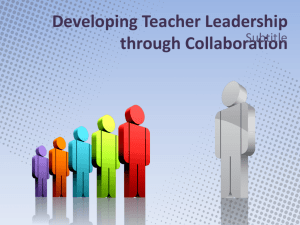
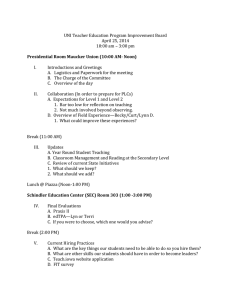
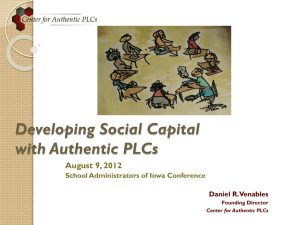
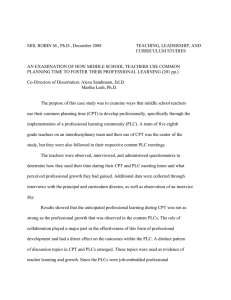
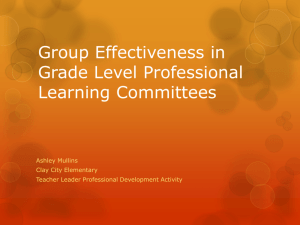
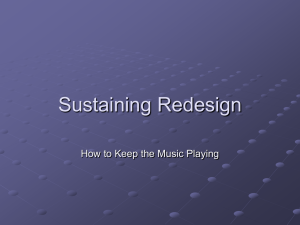
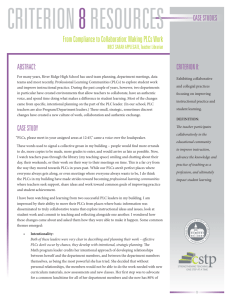
![Programmable Logic Controllers [Opens in New Window]](http://s3.studylib.net/store/data/007733338_2-48be171a8d3f2a2e43dd305c135a655d-300x300.png)
